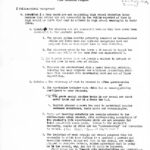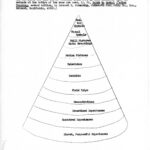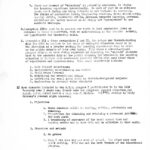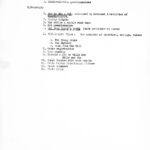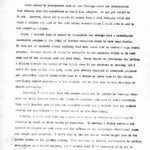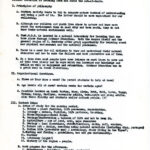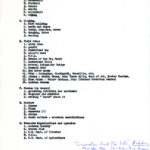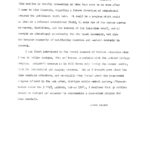Pine Mountain Settlement School
Series 09: BIOGRAPHY
Series 13: EDUCATION
Loren W. Kramer
Atossa “Toppy” Kramer
Community School Teachers, 1968-1970
Educational Planning 1969-1970
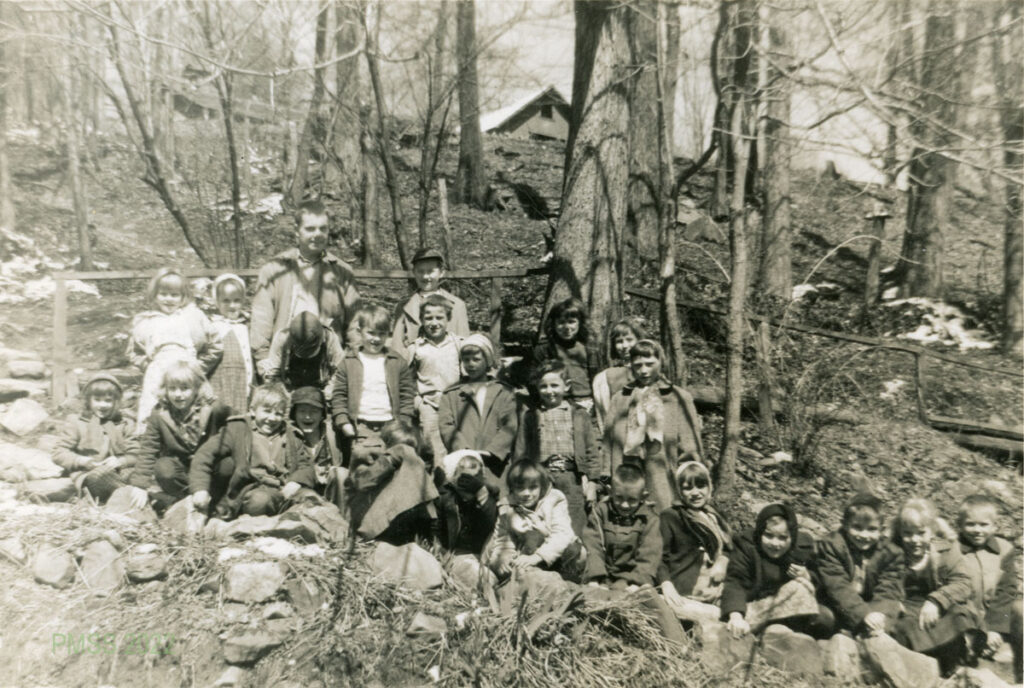
36 Loren W. Kramer with second grade class, March 1961. [kramer_l_photos_pmss_tipton036]
LOREN W. KRAMER 1969-1970 Educational Planning with Atossa Kramer
TAGS: Loren Kramer, Loren W. Kramer, Atossa ‘Toppy’ Kramer, outdoor education, environmental education, educational planning at Pine Mountain, elementary education planning, assumptions and opinions, Dr. Edgar Dale, Cone of Experience, objectives, structure and methods, materials, appendix by Toppy Kramer, folk school concept, Outdoor Education
TRANSCRIPTION: LOREN W. KRAMER Future Possibilities for the PMSS Program
[Note: The following transcription has been slightly edited for clarity.]
corr_1970_001
Some Thoughts Regarding Future Possibilities
for the Pine Mountain Program
[Handwritten notation in top margin: “March 17, 1970, by Loren & [Atossa] Toppy Kramer. (to local committee & eventually ? ? )”]
I. Philosophical Background
A. Assumption I – Many youth are not completing high school education today because they either are not successful in the skills expected of them in high school or don’t find what is offered in high school meaningful to their lives.
A. Opinion – The students are not successful because they have never been successful in the academic system.
- The school system credits primarily academic or book-oriented skills and their home and cultural background have not prepared them or encouraged them in this direction.
- The classroom group is too large : 30 cannot be taught the necessary skills at the same rate and sophistication.
- The 8-grade system does not permit a student to advance at his own pace in each area of skills.
- Teachers are overburdened with a heavy teaching schedule, covering too many subjects for efficient preparation, with much time consumed with secretarial work and out of class supervision.
B. Opinion – The relevancy of what is learned is often questionable: The curriculum includes much which has no meaning or seeming usefulness to many students.[Notation: “Example”:] 7th grade social studies texts in our school are about world trade and how it affects the U.S.
- English grammar assumes the need to understand complex sentence structures, their parts and terminologies.
- Texts and teaching materials are usually oriented to the middle-class urban student, with corresponding assumptions of the student’s life experiences which are not accurate for rural non-middle class youth. Issues in the student’s community, county, or state are too “controversial” for discussion in school. Notation: “(See Dale’s “Cone of Experience”)
- The isolation of most schools and school programs from the community in which they function is a handicap – parents and community members seldom set foot in the school, are seldom tapped as a source persons, seldom understand what is going on in the school, why, and how it could be improved.
Field trips are so fraught with technicalities and limitations they are seldom considered by teachers to be worth the effort. *(A large step to overcome several of these problems would be to make use of many of the parents part time as aides in supervising, record-keeping, drill work, resource persons in specific experience-relating, organizers, and chaperones for field trips.)
corr_1970_001a
THE DALE “CONE OF EXPERIENCE”
Dr. Edgar Dale of the Ohio State University has depicted the variety of methods possible for experience and learning. He points out that each method has its place but that slower students learn best in most instances when the methods at the bottom of the cone are used. (p. 81, Guide to Social Studies Teaching, second edition, by Leonard S. Kenworthy, Wadsworth Publishing Co., Inc., Belmont, California, c1966.)
Verbal Symbols
Visual Symbols
Still Pictures – Radio Recordings
Motion Pictures
Television
Exhibits
Field Trips
Demonstrations
Dramatized Experiences
Contrived Experiences
Direct, Purposeful Experiences
corr_1970_002
-2-
- Since our concept of “education” is primarily academics, it limits the learning experience tremendously. So much of what we as citizens learn about living and being citizens is not included in academics. The fields of productive labor, imaginative creation, human relationship, special skills, leadership skills, personal economic planning, personal avocations are barely touched on or simply not “appropriate” to our academic settings.
B. Assumption II – The goal is to prepare our youth to lead productive lives as citizens in their communities, with an understanding of the broader society, and opportunity for leadership roles.
C. Assumption III – Given assumptions I and II, the unique and forward-looking fole for PMSS to explore in the realm of meaningful education would be in the direction of a broader setting for learning experiences than is found in the public schools of this area today. This means a several-pronged program without an overriding objective of returning the “wayward” students back to the academic fold of the public schools, but broadening the learning situation to include some necessary academic skills with many other kinds of experiences and opportunities. This would conceivably include:
- Work (labor) experiences
- environmental understanding and values
- field trips (travel)
- vocational and avocational skills
- individual and small group study in student-designated subjects
- exploration in personal value standards
II Some elements included in the N.Y.C. program I participated in in the LKLP 4-county area 3 years ago. (There were two programs: general education and G.E.D. which worked toward a high school diploma. This latter was similar to Milly Mahoney‘s present night classes.)
A. Objectives
- Basic academic skills in reading, writing, arithmetic, and speaking
- Preparation for obtaining and retaining a permanent job for each youth
- A broadening of awareness of the world around them and knowing better how to cope with and be effective in that world.
B. Structure and Methods
- No grades
- Only 1 six-hour day per week of school. The other days were spent working. This was not the best feature of the educational program.
- Reading – programmed, high-interest/low level materials: Step Up Your Reading Powers, [Notation: “James Olsen. McGraw-Hill Book Co. c1967″]
a. use of daily reading needs
b. News for You – weekly
4. Writing – letters (to unions, for information, job application)
corr_1970_003
-3-
5. Speaking – discussions, current events, aspects of their life, role playing
6. Self-evaluation questionnaires
C. Materials
- How to Get a Job, published by National Association of Manufacturers.
- Family Budgets
- Map skills – mostly road maps
- Job questionnaire
- Get Your Money’s Worth (same publisher as above)
- full-length films – for analysis of characters, message, values.
a. The Young Lions
b. The Hustler
c. Home from the Hill - Voter registration
- Role playing
- Records – Ode to Billy Joe, Billy and Sue
- Short Stories with work sheet
- State Police Educational officer
- Guest speakers
- Field trips
corr_1970_004
-4-
Appendix by Toppy Kramer
Loren wanted to incorporate some of his findings about the Scandinavian Folk Schools with his experience in the N.Y.C. program. He may get around to it yet. However, there are a couple of points that I feel strongly about and which I believe are part of the folk school concept which I would like to add to the preceding outline.
First, I believe that it cannot be emphasized too strongly that a potentially successful program in the field of further education needs to have many facets. It must not be centered around anything that even looks like an academic high school program. Courses should of course be available in the academic fields to be used when and if the students want and need them. There should be provisions for getting a diploma through the taking of the G.E.D. exam if the students so desire, but I don’t see this as the only goal. Loren gave several examples of alternate programs and activities, many of which might lead to a desire to learn some of the skills previously deemed necessary by the student, but he must come to this decision or desire personally.
Secondly, I would hope that the program would not be limited to teen-age dropouts but could include anyone who wished to continue some part of their education. This would involve more of our own community people and I believe that the contact between the generations in the school would be most beneficial.
Thirdly, I would hope that any program here would be autonomous, especially in relation to local or state boards of education. To develop a really exciting and innovative program we must shake of the shackles of the cumbersome educational dogma and single goal programs. I don’t want to see the school become bogged down in the credit system or the grading system. This may lead to initial difficulties in getting recognition as a viable program, but I believe that it is necessary if we are to really move out into the wide spectrum of educational possibilities.
GALLERY: LOREN W. KRAMER Education Planning with Atossa Kramer 1970
- kramer_l_corr_1970_03_17_001
- kramer_l_corr_1970_03_17_001a
- kramer_l_corr_1970_03_17_002
- kramer_l_corr_1970_03_17_003
- kramer_l_corr_1970_03_17_004
TRANSCRIPTION: LOREN W. KRAMER Education Outdoor Planning 1969
outdoor_planning_001-1
[Note: The following transcription has been slightly edited for readability.]
Outdoor Education at the Pine Mountain Settlement School
(some initial thoughts, Feb. 1969)
Outdoor Education is learning from and about the out-of-doors.
I. Principles of Philosophy
- Western society tends to try to conquer nature instead of understanding and being a part of it. The latter should be more emphasized for our well-being.
- Although our children and youth live close to nature and know more about the environment than do most city and town youth, they do not know their natural environment well.
- The P.M.S.S. is located in a natural laboratory for learning that can take place through Outdoor Education. Both the carpus itself and the general region of E. Kentucky offer great opportunities for learning about our physical environment and the natural processes.
- There is a need for all citizens to know and understand their natural resources and how to make the fullest and most productive use of them.
- In a time when most people have some leisure we must learn to make use of this time wisely and in ways which can increase our knowledge and skills as well as enjoyment and relaxation. Outdoor Education can do a great deal in these directions.
II. Organizational Questions
- Three or four days a week? (to permit students to help at home)
- Age level: all at once? certain weeks for certain ages?
- Possible leaders on hand: Burton [Rogers], Mary [Rogers], Alvin [Boggs], Brit [Wilder], Matt [Boggs], Loren, Toppy, Vernon, Nancy [Sather], Marilynn, community adults, teenagers, and young adults. Also, Berea faculty and students and/or Antioch people. (?)
III. Content Ideas
A. Areas of study for the morning period.
- Botany – plant families, life processes, reproduction,
- Zoology – animal, families, life patterns, tracking,
- Micro-biology-natural forms.
- Ecology/Conservation – balance of life and how to keep it.
- Agriculture – use of land, soil, maps resources
- Geology – Land formations, stratifications, rocks, soil, erosion,
- Nature Art – design, creating using natural materials (including clay, photography)
- Indian Life (pre-white man) – Archaeology, study living in the “open.”
- Hunting and fishing – guidelines, bow and gun marksmanship.
- Weather
- Astronomy (night?)
- History of the region – people.
B. Work program for the afternoon.
- Maintenance – buildings, grounds, equipment,
- Farming – crops, animals, forests,
- Pottery (industry)
- Conservation projects – control erosion, planned forests, soil build up, trail making,
- [left blank]
Outdoor_planning_002-1
C. Sports and Recreation
- swimming
- softball
- basketball
- football
- tennis
- crafts
- volleyball
- hiking
C. Camping
- fire-building
- knots and ropes
- tents, lean-tos, caves
- singing, tales
- cooking
E. Field Trips
- strip mine
- quarry
- Cumberland Gap
- Lilly’s Wood
- T.V.A.
- Breaks of the Big Sandy
- Cumberland Falls
- Natural Bridge-Sky Bridge
- Mammoth Cave
- Red River Gorge
- City- Lexington, Cincinnati, Knoxville, etc.
- dramas – Daniel Boone, Unto These Hills, Book of Job, Barter Theatre,
- Glen Helen – Yellow Springs, Ohio (Outdoor Education Center)
- Audubon Museum
F. Museum (on campus)
- gathering artifacts and specimens
- displays and exhibits
- writing “books” about it
G. Culture
- dramas
- films
- concerts (?)
- cities
- rural culture – mountain contributions
H. Resource Organizations and Agencies
- Audubon Society
- Sierra Club
- U.S. Dept. of Interior
- T.V.A.
- U.S. Dept. of Agriculture
[Handwritten notation in bottom margin: “Conservation Joins the 3 R’s” Audubon, Mar.-Ap. 1966. (Ann Arbor, Mich. Program – 3 pp. with 2 photos)”]
Outdoor_planning_003-1
October, 1969
This outline is briefly presenting an idea that came to me soon after I came to Pine Mountain, regarding a future direction of educational program the Settlement might take. It could be a program which would a) lead in a relevant educational field, b) make use of its unique campus resources, facilities, and the talents of its long-time staff, and c) provide an educational opportunity for the local community, but also the broader community of neighboring counties and Eastern Kentucky in general.
I was first introduced to the formal concept of Outdoor education when I was in Yellow Springs, Ohio, and became acquainted with the Antioch College program. Antioch’s program is in full force only during the summer months, with its residential and camping program. But as I thought more about the Pine Mountain situation, and especially when I read about the year-round program offered in the Ann Arbor, Michigan, public school system, (“Conservation joins the 3 R’s”, Audubon, Mar-Ap 1966), I realized that my outline should be revised and expanded to accommodate a year-round program for Pine Mountain. — Loren Kramer
GALLERY: LOREN W. KRAMER Education Outdoor Planning
- kramer_l_edu_outdoor_planning_001
- kramer_l_edu_outdoor_planning_002
- kramer_l_edu_outdoor_planning_003
Return To:
LOREN W. KRAMER Staff – Biography
LOREN W. KRAMER Correspondence Guide and Acquisition List
See Also:
ATOSSA (“Toppy”) KRAMER Staff – Biography
LOREN W. KRAMER 1970 First Earth Day at Pine Mountain
NANCY SATHER Correspondence 1969 Educational Planning

